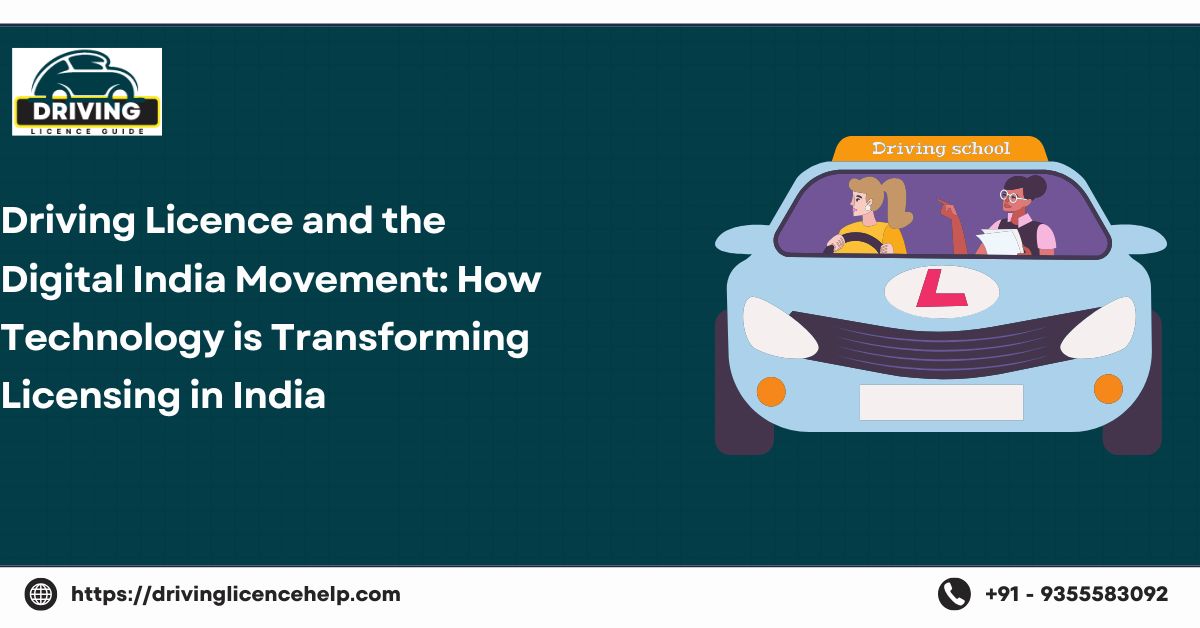Introduction
In the era of smartphones, e-governance, and digital wallets, India is undergoing a massive transformation with its Digital India initiative. One of the key sectors where this transformation is visible is the transport and licensing system. Today, applying for, receiving, and using a Driving Licence (DL) in India is no longer a tedious, paper-heavy, time-consuming process. Instead, it's being revolutionised through technology, automation, and digital platforms.
This article explores the unique topic of how the Driving Licence system is evolving in line with the Digital India movement, what benefits it brings to Indian citizens, especially the youth, and how it is improving transparency, accessibility, and road safety.
Driving Licence in India: A Brief Overview
A Driving Licence is a mandatory legal document that permits a person to drive vehicles on Indian roads. It is issued by the Regional Transport Office (RTO) of the applicant's state and is categorised based on vehicle type – two-wheeler, LMV (light motor vehicle), HMV (heavy motor vehicle), etc.
Traditionally, the process to get a driving licence involved:
- Visiting the RTO multiple times
- Submitting physical forms and photographs
- Taking the learner’s test and the driving test manually
- Long waiting periods for approval and delivery
However, with Digital India, this entire journey is being reshaped.
The Digital India Vision: Transforming Governance
Launched in 2015, the Digital India initiative aimed to “transform India into a digitally empowered society and knowledge economy.” Key pillars include:
- Digital infrastructure as a utility for every citizen
- Governance and services on demand
- Digital empowerment of citizens
This vision is being implemented in sectors like healthcare, banking, education, and transport.
DigiLocker and Digital Driving Licence
One of the most visible examples of Digital India is DigiLocker, a government-backed platform that allows users to store and access official documents online.
Digital DL and RC
You can now store your Driving Licence and Registration Certificate (RC) in DigiLocker. These are considered legally valid, just like physical documents.
Benefits of DigiLocker DL
- No need to carry a physical copy
- Quick access during checks
- Protection from loss or damage
- Accepted by the traffic police across India
How to Use It
- Download the DigiLocker app
- Link Aadhaar and mobile number
- Search for DL under “Issued Documents”
- Fetch your digital copy from MoRTH (Ministry of Road Transport and Highways)
Contactless Licence Issuance in Post-COVID Era
With COVID-19 accelerating the adoption of contactless services, RTOs across India now offer contactless licence processes:
- Online document upload
- Aadhaar eKYC verification
- Video-based learning modules
- QR code-based authentication
- AI-driven driving test infrastructure
This reduces in-person contact while speeding up the process.
Artificial Intelligence in Driving Tests
Some states like Telangana, Uttar Pradesh, and Delhi have introduced AI-enabled automated driving test tracks.
How It Works
- Cameras and sensors monitor driving manoeuvres
- AI evaluates turning, reverse parking, and lane discipline
- Instant pass/fail decisions
- No human examiner = no bias
Benefits
- Transparency
- Fair evaluation
- Reduction in human error or bribery
- Shorter testing duration
Mobile Apps for Licence Preparation and Services
Several apps are available to help applicants prepare for the learner’s test, understand traffic signs, and book appointments:
RTO Exam App
- Mock tests
- Video lessons
- Available in Hindi, English, and regional languages
mParivahan
- Check DL and RC status
- Virtual DL/RC storage
- Report stolen vehicles
- Access traffic rules
These tools empower people digitally and reduce reliance on agents.
Driving Licence as a Digital Identity Document
The Driving Licence is not just a vehicle permit, it is also a valid identity and address proof.
Accepted in:
- Bank account opening
- KYC verification
- Hotel bookings
- Police verification
- Insurance and rentals
With digital storage, your ID is always available in a secure, cloud-based system—reducing chances of fraud or duplication.
E-Challan and Online Penalty Payment
The integration of DL with traffic enforcement systems means violations are automatically recorded. With e-challan systems:
- Offences like speeding or signal jumping trigger camera-based fines
- Notification is sent via SMS
- You can pay the fine online via Parivahan
This encourages discipline and avoids bribe-based settlements.
Impact on Youth and Job Market
For India’s growing youth population, a digital driving licence is more than just convenience it opens new employment avenues.
Job Opportunities
- Delivery riders (Zomato, Swiggy, Blinkit)
- Cab drivers (Ola, Uber)
- Warehouse and transport assistants
- Ambulance drivers and emergency responders
- Driving instructors
Easy Verification
Employers can verify the authenticity of a digital DL via QR code or Parivahan API.
Cybersecurity and Privacy Concerns
With digitisation comes the need to protect personal information.
Safeguards in Place
- DigiLocker uses Aadhaar-based OTP login
- All data is encrypted
- Government servers comply with MeitY guidelines
- Mobile OTPs for every transaction
Still, users should be cautious:
- Never share OTPs or passwords
- Use only official websites and apps
Note:- How to Apply for a Driving Licence in India- Online/Offline
Conclusion
The humble Driving Licence has come a long way—from a paper document issued after hours of standing in queues, to a digitally empowered, AI-verified, QR-scannable, cloud-stored identity tool.
Thanks to the Digital India initiative, what once seemed like a bureaucratic hurdle is now a model of efficient governance and citizen convenience. For the youth, gig workers, and professionals of India, the digital driving licence is more than just permission to drive—it's a gateway to independence, employment, and digital empowerment





Comments